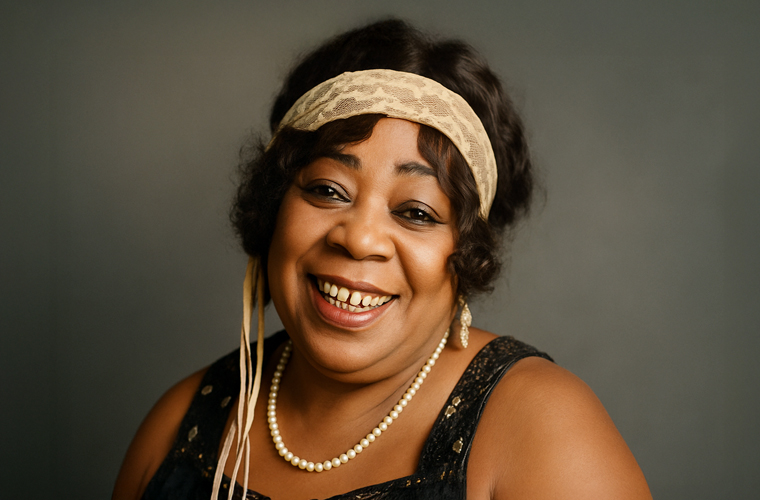The Mother of the Blues
Gertrude “Ma” Rainey (1886–1939) was a pioneering American blues singer, performer, and entrepreneur who earned the enduring title of “Mother of the Blues.” Born into the vibrant world of African American minstrel shows in the post-Reconstruction South, Rainey became one of the first professional blues vocalists, blending raw emotional depth with theatrical flair to capture the joys, sorrows, and resilience of Black life. Her powerful contralto voice, infused with “moaning” techniques and unapologetic themes of love, sexuality, and hardship, helped elevate the blues from rural folk expression to a commercial genre that influenced jazz, gospel, and modern music.
Gertrude Pridgett was born on April 26, 1886, in Columbus, Georgia—a bustling river port and hub for traveling minstrel troupes—to Thomas Pridgett Sr., a minstrel performer, and Ella Allen Pridgett, a vaudeville singer and dancer. As the second of five children in a working-class family, she grew up immersed in performance culture, attending the First African Baptist Church and participating in local talent shows. By age 12 or 14, she made her stage debut in Columbus’s “A Bunch of Blackberries” revue at the Springer Opera House, showcasing her singing and dancing skills. Though details of her childhood are sparse and sometimes disputed—some sources suggest a birth year of 1882 in Alabama—Rainey’s early exposure to Black entertainment circuits laid the foundation for her career.
Rainey’s introduction to the blues came around 1902 during a performance in a small Missouri town, where she heard a young woman sing a haunting, improvised song of lost love. Captivated, Rainey incorporated similar “strange” tunes into her act, later claiming to have coined the term “blues” after incorporating them into her repertoire. This moment marked her shift from traditional vaudeville songs to the raw, secular style that would define her legacy.






In February 1904, at age 17, Gertrude married fellow performer William “Pa” Rainey, a comedian and manager, adopting the stage name “Ma Rainey” in honor of his nickname. The couple toured the South’s tent shows and minstrel circuits, joining outfits like Pat Chappelle’s Rabbit Foot Minstrels in 1906, where they were billed as “Black Face Song and Dance Comedians, Jubilee Singers, and Cake Walkers.” By 1910, Rainey was hailed as a “coon shouter,” a term for energetic performers of dialect songs, but she soon pivoted to blues, billing herself and Pa as the “Assassinators of the Blues” by 1914.
Wintering in New Orleans around 1916 exposed Rainey to jazz innovators like Louis Armstrong, Sidney Bechet, and King Oliver, enriching her sound with brass and improvisation. That same year, she and Pa separated but continued collaborating professionally; they adopted a son, Danny, who occasionally joined their act. During this period, Rainey mentored a young Bessie Smith while touring with the Moses Stokes Company, though legends of Rainey “teaching” Smith the blues are likely exaggerated—Smith was already a rising talent.
Rainey’s breakthrough came in 1923 when Paramount Records producer J. Mayo “Ink” Williams discovered her in Chicago. She recorded her debut session that December, releasing hits like “Bo-Weevil Blues,” “Moonshine Blues,” and “Bad Luck Blues.” Over the next five years, she cut nearly 100 sides for Paramount, often backed by top musicians: Thomas Dorsey on piano, Louis Armstrong on cornet, Fletcher Henderson on arrangements, and Tampa Red on guitar. Standout tracks included “See See Rider Blues” (1924), a blues standard; “Ma Rainey’s Black Bottom” (1927), which popularized a dance craze; and the boldly suggestive “Prove It on Me” (1928), rumored to nod to her own same-sex attractions following a 1925 arrest for an alleged “degenerate party.”
Touring the Theater Owners Booking Association (TOBA) circuit with her Georgia Jazz Band and Wildcats Jazz Band from 1924 to 1928, Rainey commanded stages in glittering gowns, diamond tiaras, gold teeth, and ostrich plumes—earning monikers like “Gold-Neck Woman of the Blues” and “Paramount Wildcat.” She wrote or co-wrote about a third of her material, addressing taboo topics like infidelity, domestic violence (in “Black Eye Blues,” 1930), and female empowerment with unfiltered candor. At her peak, she earned up to $350 weekly—lavish for the era—while defying racial and gender norms on segregated circuits.
Rainey’s personal life was as bold as her performances. Though married to Pa until around 1916, she embraced fluid sexuality, with close bonds to women like Bessie Smith (who once bailed her out of jail) and lyrics hinting at queer experiences. A shrewd businesswoman, she later owned theaters in Georgia, including the Liberty Theater in Columbus and venues in Rome. Her stage persona—emerging from a giant phonograph horn amid a chorus line—blended vaudeville spectacle with blues authenticity, making her a folk hero who spoke directly to Black women’s realities.
By the early 1930s, the Great Depression and the TOBA’s collapse curtailed vaudeville, prompting Rainey to retire from touring in 1935 after her mother and sister’s deaths. She managed her Columbus theaters and stayed active in the Friendship Baptist Church until a heart attack claimed her life on December 22, 1939, at age 53.
Rainey’s influence endures as the architect of “classic blues,” bridging Southern folk traditions with urban jazz and empowering generations of Black artists. She mentored figures like Bessie Smith and inspired feminist scholars like Angela Y. Davis, who hailed her songs as anthems of resistance. Posthumously inducted into the Blues Hall of Fame (1983) and Rock and Roll Hall of Fame (1990), she received a Grammy Lifetime Achievement Award in 2023. Her Columbus home became a museum in 2007, and the Ma Rainey International Blues Festival launched in 2016.
Culturally, Rainey lives on in Sterling A. Brown’s 1932 poem “Ma Rainey,” Alice Walker’s The Color Purple, and August Wilson’s play Ma Rainey’s Black Bottom (1984), adapted into a 2020 film starring Viola Davis. Tracks like “See See Rider” entered the Grammy Hall of Fame (2004) and the National Recording Registry. As scholar Sandra Lieb wrote in Mother of the Blues (1981), Rainey wasn’t just a singer—she was a revolutionary voice for the unheard, proving the blues could heal as much as it hurt.

